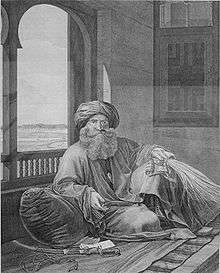Murad Bey

Murad Bey Mohammed (c. 1750 – 22 April 1801) was an Egyptian Mamluk chieftain (Bey), cavalry commander and joint ruler of Egypt with Ibrahim Bey.[1] He is often remembered as being a cruel and extortionate ruler, but an energetic courageous fighter.[1]
Biography
Murad was of Georgian origin from Tiflis,[2][3] or Circassian.[4][5] In 1768 he was sold to the (circassian) Mamluk Muhammad Bey Abu al-Dhahab in Egypt.
After the death of his master Muhammad Bey Abu al-Dhahab, Murad Bey was in command of the Mamluk army, whereas Ibrahim Bey was in charge of administrative duties of Egypt.[6] They survived through the persistent Ottoman attempts at overthrowing the Mamluk regime and civil strifes.[2] They served as kaymakams (acting governors) in Egypt on occasion, although they effectively held de facto power for decades, even over the appointed Ottoman governor of Egypt.[7][8][9]
In 1786, the Ottoman sultan Abdülhamid I sent Kapudan Pasha (grand admiral of the Ottoman Navy) and Cezayirli Gazi Hasan Pasha to drive out Ibrahim and Murad Bey.[10][11] Hasan Pasha was fervent and thorough in his efforts and succeeded in the short term, reestablishing direct Ottoman Empire control over Egypt.[10] Ismail Bey was appointed as new Mamluk leader and Shaykh al-Balad (civil governor and de facto ruler). However, in 1791, only five years after their expulsion by Hasan Pasha, the duumvirate returned to Cairo from hiding in southern Egypt and took back de facto control.[12] At this time, Murad Bey served as Amir al-Hajj (Commander of the Hajj).[13]
He commanded the Mamluk cavalry and Janissaries' infantry in the Battle of Shubra Khit on 13 July 1798, but he was defeated by the French Armée and withdrew from the fight. Eight days later, on 21 July, he commanded the Mamluk cavalry during the Battle of the Pyramids, alongside Ibrahim Bey, and was defeated at the hands of Napoleon's armies. While Ibrahim Bey fled towards Sinai, Murad had fled to Cairo first and then to Upper Egypt and began mounting a brief guerrilla campaign that staved off Desaix for a year.[6] It was while pursuing Murad Bey into Upper Egypt that the French discovered the monuments at Dendera, Thebes, Edfu and Philae.
Murad had reportedly offered money to the French forces to leave Egypt and offered to ally himself with the British in exchange for allowing the British to occupy Alexandria, Damietta and Rosetta.[1] In 1800, Murad made peace with Jean Baptiste Kléber, and agreed to garrison Cairo, but died of bubonic plague on his journey there.[2]
| Wikimedia Commons has media related to Murad Bey. |
See also
- Ibrahim Bey (Mamluk), his career-long partner in ruling Egypt
References
- 1 2 3 Goldschmidt, Arthur (2000). Biographical dictionary of modern Egypt. Boulder [u.a.]: Rienner. p. 138. ISBN 9781555872298.
- 1 2 3 Mikaberidze, Alexander, "Murad Bey", in: Gregory Fremont-Barnes (ed., 2006), The Encyclopedia of the French Revolutionary and Napoleonic Wars, Vol. 2, p. 663. ABC-CLIO, Inc.
- ↑ The Life of J. D. Åkerblad: Egyptian Decipherment and Orientalism, By Fredrik Thomasson, p.80, Hotei Publishing, Netherlands
- ↑ Kadir I. Natho: Circassian history, page 256f. Xlibris 2009
- ↑ J. Christopher Herold: Bonaparte in Egypt, pages 70 and 252. New York 1962/2009
- 1 2 Pawly, Ronald (2012). Napoleon's Mamelukes. Osprey Publishing. pp. 5–6. ISBN 9781780964195.
- ↑ 'Abd al-Rahman Jabarti; Thomas Philipp; Moshe Perlmann (1994). Abd Al-Rahmann Al-Jabarti's History of Egypt. 2. Franz Steiner Verlag Stuttgart. p. 93.
- ↑ 'Abd al-Rahman Jabarti; Thomas Philipp; Moshe Perlmann (1994). Abd Al-Rahmann Al-Jabarti's History of Egypt. 2. Franz Steiner Verlag Stuttgart. p. 138.
- ↑ 'Abd al-Rahman Jabarti; Thomas Philipp; Moshe Perlmann (1994). Abd Al-Rahmann Al-Jabarti's History of Egypt. 2. Franz Steiner Verlag Stuttgart. p. 156.
- 1 2 'Abd al-Rahman Jabarti; Thomas Philipp; Moshe Perlmann (1994). Abd Al-Rahmann Al-Jabarti's History of Egypt. 2. Franz Steiner Verlag Stuttgart. p. 181.
- ↑ Mehmet Süreyya (1996) [1890], Nuri Akbayar; Seyit A. Kahraman, eds., Sicill-i Osmanî (in Turkish), Beşiktaş, Istanbul: Türkiye Kültür Bakanlığı and Türkiye Ekonomik ve Toplumsal Tarih Vakfı
- ↑ 'Abd al-Rahman Jabarti; Thomas Philipp; Moshe Perlmann (1994). Abd Al-Rahmann Al-Jabarti's History of Egypt. 2. Franz Steiner Verlag Stuttgart. pp. 317–322, 373.
- ↑ Anderson, Robert (1998), Egypt in 1800: Scenes from Napoleon's Description de L'Egypte, Barrie & Jenkins, p. 89